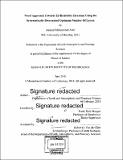Novel approach towards 1D resistivity inversion using the systematically-determined optimum number of layers
Author(s)
Alali, Ammar Mohammed
DownloadFull printable version (10.75Mb)
Alternative title
Novel approach towards one-dimensional resistivity inversion using the systematically-determined optimum number of layers
Other Contributors
Massachusetts Institute of Technology. Department of Earth, Atmospheric, and Planetary Sciences.
Advisor
Frank Dale Morgan.
Terms of use
Metadata
Show full item recordAbstract
Determining the correct number of layers as input for ID resistivity inversion is important for constructing a model that represents the subsurface accurately. Current common methods to select the number of layers are performed in one of three ways: by trial-and-error and choosing the best model data-fit, by using the modified F-test, or through trans-dimensional model parameterization. Although these methods are creative approaches, they are computationally expensive, as well as time-consuming and painstaking in practice. In this thesis, I provide a method that solves the problem of choosing the correct number of layers represented by the apparent resistivity curve. The method follows the two-steps approach suggested by Simms and Morgan (1992) to systematically resolve the optimum number of layers. The first step is to run a fixed thickness inversion using a large number of layers in which the number of layers and layer thicknesses are fixed, and resistivity values are inversion parameters. I then integrate the outcome of the first inversion (the resistivity model) to determine the optimum number of layers based on changes of the slope. The detected number of layers is used as an input parameter for the second step; which is running a variable-thickness inversion (layer thicknesses and resistivities are both inversion parameters) for the outcome, the final resistivity model. Each step uses the Ridge Trace damped least-square inversion. The two inversion steps are integrated into a software program that performs the steps sequentially. The software determines all inversion parameters from the data file in a self-consistent manner. This proposed method uses a robust ridge trace regression algorithm, which has proven to be stable, accurate, and at least a hundred times faster than current methods.
Description
Thesis: S.M., Massachusetts Institute of Technology, Department of Earth, Atmospheric, and Planetary Sciences, 2018. Cataloged from PDF version of thesis. Includes bibliographical references (pages 102-109).
Date issued
2018Department
Massachusetts Institute of Technology. Department of Earth, Atmospheric, and Planetary SciencesPublisher
Massachusetts Institute of Technology
Keywords
Earth, Atmospheric, and Planetary Sciences.